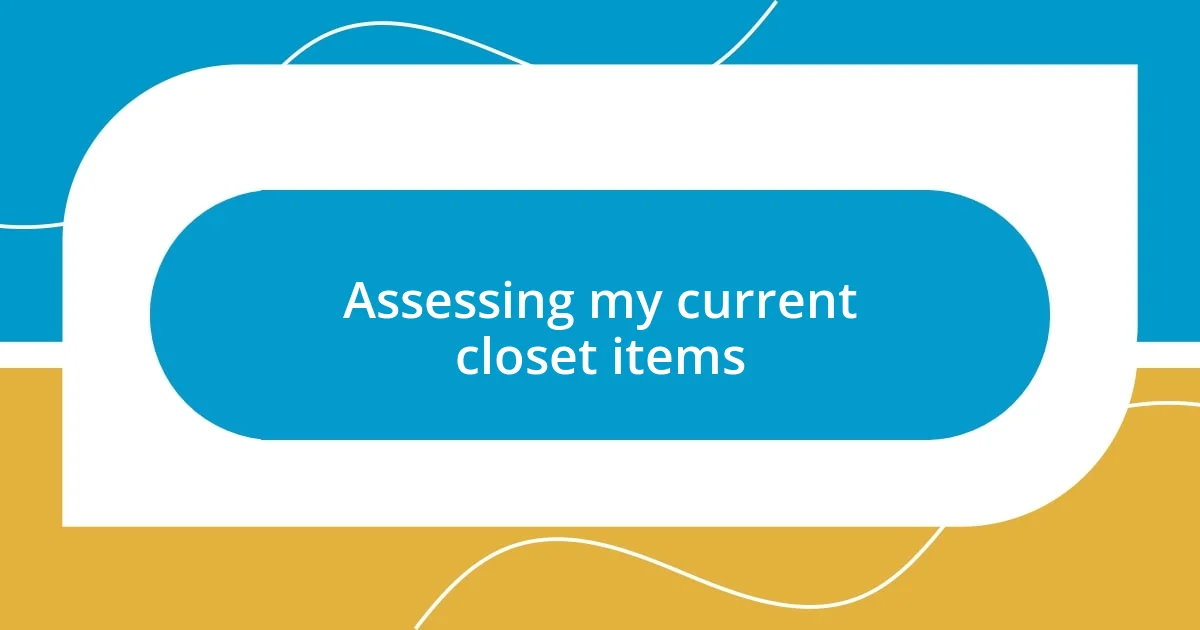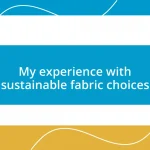Key takeaways:
- Recognizing the environmental and ethical impacts of fashion choices led to a commitment to sustainable materials and brands.
- Implementing a systematic decluttering strategy helped create a more mindful and versatile wardrobe focused on quality over quantity.
- Maintaining a sustainable closet involves practices like the “one-in, one-out” method and regular wardrobe audits to ensure alignment with personal values.

Understanding sustainable fashion choices
Sustainable fashion choices can sometimes feel overwhelming, especially when faced with countless labels and ethical considerations. I remember the first time I read about fast fashion’s impact on the environment; it struck me like a wake-up call. How could something as simple as clothing contribute to pollution and waste?
When I started exploring sustainable options, I learned about different materials, like organic cotton and Tencel, which are made from sustainably sourced wood pulp. I’ll never forget the rush of excitement when I found a cozy sweater made from recycled fibers—it felt as if I was making a little difference with each piece I chose. It really made me think: what if every outfit I wore was not just a fashion statement but also a step toward a healthier planet?
There are also brands committed to ethical labor practices, and supporting them can feel deeply satisfying. I still get a rush when I discover companies that pay fair wages and provide safe working conditions. Isn’t it incredible to think that my shopping choices can support not just the environment, but also the people behind the clothes I wear?

Assessing my current closet items
As I began the journey of assessing my closet, I realized it wasn’t just about the quantity of items I owned but their quality and impact. I vividly recall going through my wardrobe, holding up each piece and asking myself if it sparked joy or simply filled space. The feeling of liberation that came from parting with clothes I hadn’t worn in ages was incredible. It felt like a weight being lifted off my shoulders.
I made a simple spreadsheet to categorize my items based on condition, frequency of wear, and sustainability. This wasn’t just an organizational task; it was enlightening. For instance, seeing that I wore my eco-friendly denim far more often than my synthetic alternatives made me reflect on what I truly valued in my wardrobe. Wouldn’t you agree that understanding our habits holds the key to making more mindful choices?
Going through this process also taught me the importance of versatility in clothing. I found some classic pieces that could be styled in multiple ways, which spoke to my desire for a more curated and sustainable wardrobe. To highlight these insights, here’s a comparison of my closet items:
| Item | Category |
|---|---|
| Eco-friendly Denim | Frequent Wear |
| Fast Fashion Blouse | Rarely Worn |
| Classic Black Dress | Versatile Piece |
| Recycled Fiber Sweater | Loved & Worn Often |
| Synthetic Jacket | Occasional Use |

Choosing sustainable materials wisely
When delving into sustainable materials, I found that not all fabrics are created equal, and this realization was a game changer for me. While shopping, I began to pay close attention to labels and the stories behind the materials. I’ll never forget holding a soft hemp shirt in my hands; it was light yet strong, and knowing it required less water to grow compared to cotton really struck me. That’s when I understood that choosing the right materials could dramatically lessen my environmental footprint.
Here are some sustainable materials I’ve come to appreciate, alongside their benefits:
- Organic Cotton: Grown without harmful pesticides, it’s kinder to both the environment and our skin.
- Tencel (Lyocell): Made from sustainably sourced wood pulp, it’s biodegradable and produced in a closed-loop system.
- Recycled Polyester: Diverted from landfills, it’s made from used plastic bottles and reduces waste.
- Hemp: One of the most eco-friendly fibers, it grows quickly and requires minimal resources.
- Bamboo: Naturally antibacterial and biodegradable, it grows rapidly and absorbs more carbon dioxide than trees.
Embracing these materials transformed my shopping habits. When I discovered a brand that utilized organic cotton in their apparel, I felt a sense of pride. It was like joining a community committed to positive change, and that connection fueled my journey. I learned that each piece I invested in not only made me feel good but also made a difference—for the Earth and for my personal values.

Implementing a decluttering strategy
As I set out to declutter my closet, I adopted a methodical strategy called the “Four-Box Method.” This involves designating boxes for keep, donate, sell, and trash. I remember the moment I held up a sequined top I had worn once to a party; the guilt of it sitting unused was outweighed by the realization that someone else might love it. Have you ever felt that hesitation when letting go of something you once treasured?
During the decluttering process, I found it helpful to set a specific time limit. This kept me focused and made the task feel less overwhelming. I dedicated an hour each weekend to tackle a section of my closet. Not only did this structure help me stay committed, but it also transformed decluttering into a ritual of renewal—every session felt like I was clearing space not just in my closet, but also in my mind.
Lastly, I adopted a rule: if I didn’t wear it in the last year, it’s time to let it go. This mantra proved liberating. I can still picture the moment I folded a once-favorite dress and placed it in the donate box. Rather than sadness, I felt a rush of excitement knowing it could find a new home. By implementing this decluttering strategy, I learned that letting go is not just about emptying physical space; it’s about making room for new possibilities.

Curating a sustainable wardrobe
Curating a sustainable wardrobe involves more than just choosing eco-friendly materials; it’s about understanding personal style and aligning it with ethical preferences. I remember a moment when I tried on a beautifully tailored garment that didn’t sit right. Though it was made from organic cotton, I realized I’d never wear it. Have you ever bought something just because it was eco-friendly, only to let it gather dust? That’s where I learned the importance of intentionality in my wardrobe choices.
A pivotal experience for me was when I discovered capsule wardrobes—a concept that emphasizes quality over quantity. Creating my own capsule helped me appreciate versatility; each piece had to mix and match seamlessly. I recall pulling together an outfit from just ten items and feeling surprisingly stylish. This approach not only reduced my consumption but also made me more creative with my outfits. With fewer pieces, I began to cherish each one for its unique role in my wardrobe.
Lastly, I vowed to invest in brands that prioritize sustainability, even if it meant spending a bit more. When I purchased a hand-knit sweater from a fair-trade company, I felt a connection to the artisan who crafted it. This was no ordinary transaction; it was a story tied to my clothing, and I loved wearing something that had purpose and soul. Have you ever felt that joy of wearing a piece you know supports positive change? It’s these choices that have enriched my personal style while making me a more responsible consumer.

Building a versatile outfit collection
Building a versatile outfit collection is really about having the right foundational pieces that can adapt to various occasions. I recall my excitement when I realized that a simple white button-up shirt could transition from a casual day out with jeans to an elegant evening look with a skirt. Have you ever stood in front of your closet, overwhelmed by choices yet feeling like you have nothing to wear? This is where versatility shines, making it easier to create chic ensembles without constantly buying new items.
I learned firsthand how essential it is to invest in timeless classics, like a well-fitted blazer or a little black dress. These items have served me well through countless outings and events. There was a memorable dinner party where I paired that classic blazer with a bright tank top and tailored pants, and I felt effortlessly stylish. It’s incredible how just a few versatile pieces can significantly expand your outfit possibilities.
Lastly, I discovered the power of accessories in enhancing versatility. A statement necklace or a pair of bold earrings can change the vibe of an outfit entirely. I remember dressing down a sophisticated dress with a denim jacket and casual flats, but adding a colorful scarf transformed it into something fresh. Have you noticed how a simple accessory can breathe new life into something seemingly ordinary? In my journey, I realized that creativity and intention go hand in hand, allowing me to build a wardrobe that reflects both my style and values.

Maintaining a sustainable closet routine
Maintaining a sustainable closet routine hinges on mindful practices that keep your wardrobe aligned with your values. One strategy I adopted is the “one-in, one-out” method. Whenever I buy a new piece, I commit to letting go of something old. This practice not only minimizes clutter but also keeps my collection intentional. Have you ever felt overwhelmed by clothes you rarely wear? This approach keeps my closet fresh and manageable.
I also found that regular wardrobe audits are key to sustaining my closet goals. Every few months, I evaluate what I actually wear versus what I thought I needed. I remember discovering a pair of shoes I hadn’t touched in over a year; letting them go felt freeing. It’s like a little self-check that reassures me of my choices and allows me to focus on the pieces that truly resonate with me.
Finally, I try to stay informed about the environmental impact of my fashion choices. Following brands on social media and reading ethical fashion blogs keeps me engaged and ensures my decisions align with sustainable practices. I can’t tell you how rewarding it is to know that the dress I’m wearing was made with respect for the planet. Did you ever think about how much power we have as consumers? Each choice we make contributes to a larger narrative, and I’m proud that my story reflects my sustainability values.












